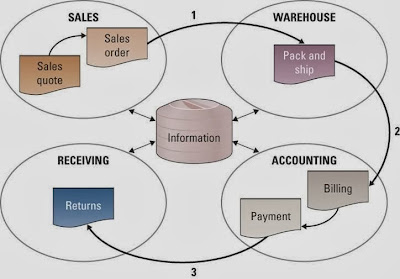Chapter 12 - Integrating The Organization From The End To End - Enterprise Resource Planning
- Serve as the organization's backbone in providing fundamental decision-making support.
- At the heart of all ERP systems is a database, when a user enters or updates information in one module, it is immediately and automatically updated throughout the entire system
.jpg)
Bringing the Organization Together
ERP enables employees across the organization to share information across a single,centralized database.
The Evolution of ERP
- to deliver automation across multiple units of an organization
- to help facilitate the manufacturing process and address issues such as raw materials, inventory, order entry and distribution
Integrating SCM, CRM, and ERP
- SCM, CRM, and ERP are the backbone of e-business
- Allows the unlocking of information to make it available to any user, anywhere, anytime
- Integration of these applications is the key to success for many companies
Integration Tools
Many companies purchase modules from an ERP vendor, an SCM vendor, and a
CRM vendor and must integrate the different modules together
- Middleware – several different types of software which sit in the middle of and provide connectivity between two or more software applications
- Enterprise application integration (EAI) middleware – packages together commonly used functionality which reduced the time necessary to develop solutions that integrate applications from multiple vendors
Enterprise Resource Planning (ERP)
- Flexible – must be able to quickly respond to the changing needs of the organization
- Modular and open – must have an open system architecture, meaning that any module can be interface, with or detached whenever required without affecting the other modules.
- Comprehensive – must be able to support a variety of organizational functions for a wide range of businesses
- Beyond the company – must support external partnerships and collaboration efforts
No comments:
Post a Comment